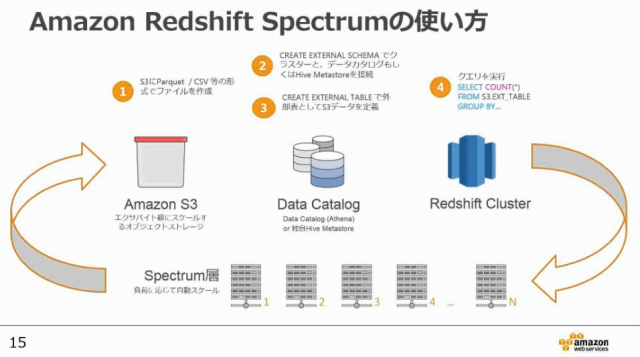
RedShift uses EC2 instances so you need to choose your instance type/size for scaling compute vertically, but you can also scale horizontally by adding more nodes to the cluster. RedShift provides Massively Parallel Processing (MPP) by distributing data and queries across all nodes. RedShift provides good query performance and compression.
#AWS REDSHIFT SPECTRUM DRIVERS#
PostgreSQL compatible with JDBC and ODBC drivers available compatible with most Business Intelligence tools out of the box.įeatures parallel processing and columnar data stores which are optimized for complex queries.

RedShift is ideal for processing large amounts of data for business intelligence.Įxtremely cost-effective as compared to some other on-premises data warehouse platforms. RedShift is used for running complex analytic queries against petabytes of structured data, using sophisticated query optimization, columnar storage on high-performance local disks, and massively parallel query execution. RedShift is an Online Analytics Processing (OLAP) type of DB. RedShift is a SQL based data warehouse used for analytics applications. A migration to the cloud, combined with a modern architecture including Amazon S3 and Amazon Redshift should be part of the new data landscape.Transform your career with cloud skills - save up to 50% with our special deals!Īmazon Redshift is a fast, fully managed data warehouse that makes it simple and cost-effective to analyze all your data using standard SQL and existing Business Intelligence (BI) tools.Ĭlustered peta-byte scale data warehouse. The business needs to evolve even more drastically and often to a point when the EDW fails to keep up.Īn EDW can be improved but at times, it is simply more strategic to rebuild and rearchitect the solution, as both technology, business needs, and priorities have changed too much. Over time, standards and architecture evolve drastically increasing the costs required to maintain the older platform. Re-architecture of legacy EDWĭespite the costs associated with early Data Warehouses, some organizations made good use of them and still had an upper hand amongst their competitors. More importantly, it does not suffer from the same limitations and will not constrain an organization from any use cases it is considering. Redshift has a lower price point than all those options, by orders of magnitude at times.


Later implementations of SQL Server had a lower price point but all of them were limited in their ability to support analytics in a true Big Data world, thus imposing constraints. Amazon Redshift, working in tandem with Redshift Spectrum and Amazon S3 enable a Lake House Architecture, combining the best of the Data Warehouse and Data Lake platforms.Įarly adopters of Data Warehouse have implemented solutions like Teradata, Oracle and Netezza, which could handle large volumes of data but at a high price point. Typical organizations will need a robust database to allow the democratization of analyses to a large number of users across the enterprise, handling various use cases and complexity. As part of a modern architecture, organizations inevitably implement a Data Lake to support their analytical needs, but this is just the beginning of the journey.


 0 kommentar(er)
0 kommentar(er)
